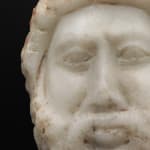Marble Head of Silenus, c. 200 CE to 400 CE
Marble
18 x 14 x 12 cm
7 1/8 x 5 1/2 x 4 3/4 in
dimensions given without mounting
7 1/8 x 5 1/2 x 4 3/4 in
dimensions given without mounting
LI.3405
Further images
-
(View a larger image of thumbnail 1
)

-
(View a larger image of thumbnail 2
)

-
(View a larger image of thumbnail 3
)

-
(View a larger image of thumbnail 4
)

-
(View a larger image of thumbnail 5
)

-
(View a larger image of thumbnail 6
)

-
(View a larger image of thumbnail 7
)

-
(View a larger image of thumbnail 8
)

-
(View a larger image of thumbnail 9
)

-
(View a larger image of thumbnail 10
)

This fascinating head of Silenus presents an oval face with an almost completely bald head and symmetrical bushy eyebrows over small almond shaped and heavy lidded eyes; squat, bulbous nose;...
This fascinating head of Silenus presents an oval face with an almost completely bald head and symmetrical bushy eyebrows over small almond shaped and heavy lidded eyes; squat, bulbous nose; full lower lip, the upper lip being entirely buried under a pair of luxuriant moustaches merging in a dense beard.
The statuette is entirely hollow and there are three evident and neatly bored perforations, two on the boar (underbelly and hind side) and one on the back of Silenus.
In Greek mythology, Silenus was tutor to the wine god Dionysus and one of his companions. He is typically represented as older than the satyrs of the Dionysian retinue.
The original Silenus was initially associated to a rustic man of the forests, having the ears of a horse and sometimes also the tail and legs of a horse. Around the end of the 6th century BC, the name Silenus was applied to Dionysus’ foster father, which thus aided the gradual absorption of Satyrs and Sileni into the Dionysiac cult. Silenus, although bibulous like the Satyrs in the Satyr plays, also appeared in Orphic hymns to be the young god's tutor and a dispenser of domestic wisdom. Sileni are mostly portrayed on ceramics as drunken members of the Dionysian thiasos, notorious consumers of copious quantities of wine, habitually bald and overweight, with thick lips, squat noses and human legs, supported by satyrs or carried on by a donkey. Later still, the plural "sileni" went out of use and the only references were to one individual named Silenus, the teacher and faithful companion of the wine-god Dionysus, described as the oldest, wisest and most jovial of the followers of Dionysus.
The statuette is entirely hollow and there are three evident and neatly bored perforations, two on the boar (underbelly and hind side) and one on the back of Silenus.
In Greek mythology, Silenus was tutor to the wine god Dionysus and one of his companions. He is typically represented as older than the satyrs of the Dionysian retinue.
The original Silenus was initially associated to a rustic man of the forests, having the ears of a horse and sometimes also the tail and legs of a horse. Around the end of the 6th century BC, the name Silenus was applied to Dionysus’ foster father, which thus aided the gradual absorption of Satyrs and Sileni into the Dionysiac cult. Silenus, although bibulous like the Satyrs in the Satyr plays, also appeared in Orphic hymns to be the young god's tutor and a dispenser of domestic wisdom. Sileni are mostly portrayed on ceramics as drunken members of the Dionysian thiasos, notorious consumers of copious quantities of wine, habitually bald and overweight, with thick lips, squat noses and human legs, supported by satyrs or carried on by a donkey. Later still, the plural "sileni" went out of use and the only references were to one individual named Silenus, the teacher and faithful companion of the wine-god Dionysus, described as the oldest, wisest and most jovial of the followers of Dionysus.









